Mint is a small, modest-looking herb with a powerful scent, as expressed in the Greek myth of the nymph Mintha: abandoned by her lover, the king of the underworld, for a more noble goddess, she is transformed by the latter into a small, insignificant herb, but her ex-lover grants her the right to become a fragrant plant called minthé, “with a good smell”. The Lao language refers to this good smell to name the plant: mint is “the vegetable that smells good”, phak hom, and is thus the paradigm of the aromatic plants, the “fine herbs” we have already mentioned.
Mint, or rather mints, are herbaceous perennials with angular stems that propagate by stolons; the leaves, which vary in shape depending on the species, are opposite, toothed and highly aromatic; the flowers are grouped in dense whorls forming spikes or heads. Among the most commonly cultivated are spearmint, M. spicata, native to Europe, which gives its fragrance to the famous mint tea of North Africa; peppermint, M. piperata, which is thought to be a hybrid of spearmint and peppermint. piperata, thought to be a hybrid of the former, has a very fresh, aromatic scent, with an “icicle” effect, as in “menthol-fresh” chewing gum; M. crispa, on the other hand, has a more herbal, green-grass scent, reminiscent of “chlorophyll-flavored” chewing gum. M. arvensis, phak hom gnipoun, is also found in Laos, from which the Japanese have been extracting an essential oil for centuries. Markets all over the world sell a large number of hybrids whose species of origin is difficult to determine, and which can be distinguished by the shape of their leaves and their more or less peppery, more or less mentholated scent, to which, as with wines, tones of orange, pineapple, grapefruit, apple and even eau de Cologne are attributed.
While in the West mint is not traditionally used in cooking (with the exception of the famous and not very good English mint sauce), in the East the leaves are a common ingredient in many culinary preparations. In Laos, mint is sometimes called phak hom lap, which is a clear indication of its use, for not only is mint mixed with most laps, but mint leaves are always part of the vegetable platters that accompany them, as well as grilled meat or fish. In Vietnam, you can’t imagine a good phò or bi boun without mint, and spicy Thai beef salads are abundantly covered with these leaves. But mint leaves are never cooked, and are only added as a final ingredient to the various preparations. Cooking mint as an infusion or decoction is a medicinal preparation. In Laos, for example, a lightly salted mint broth is prepared to purify the blood and cleanse the intestines; this use is almost universal, as aromatic plants always have two functions: one is to give flavour to culinary preparations, the other to make them easier to digest. Mint leaves are also used externally for headaches, sprains and insect bites.
While all mints are reputed for their medicinal properties, peppermint is especially cultivated for this purpose, as it can contain up to 90% menthol, which is an antiseptic, antispasmodic and analgesic, and leaves a cold sensation in the mouth. We can’t list all the products that contain it: confectionery, syrups, alcohol, but also medicines, toothpaste, perfumes, household products, insecticides… etc.
Let’s conclude with a French proverb whose interpretation we leave to the reader:
A woman is like a mint leaf: the more you crumple it, the more it smells.
La Menthe est une petite herbe à l’allure modeste mais à l’odeur puissante, c’est ce qu’exprime le mythe grec de la nymphe Mintha: délaissée par son amant, le roi des enfers, pour une déesse plus noble, elle est transformée par celle-ci en une petite herbe insignifiante, son ex-amant lui accordant cependant de devenir une plante odorante appelée minthé, « à la bonne odeur ». La langue lao se réfère à cette bonne odeur pour nommer la plante: la menthe est « le légume qui sent bon », phak hom, elle est ainsi le paradigme des plantes aromatiques, des « fines herbes » que nous avons déjà évoquées.
La menthe, il faudrait plus tôt dire les menthes, sont des herbacées vivaces aux tiges anguleuses qui se propagent par stolons; les feuilles dont la forme varie selon les espèces sont opposées, dentées et très aromatiques; les fleurs sont groupées en verticilles denses formant des épis ou des têtes. Parmi les plus couramment cultivées on peut citer la menthe verte, M. spicata, originaire d’Europe qui donne son parfum au fameux thé à la menthe d’Afrique du Nord; la menthe poivrée, M. piperata qui serait un hybride de la précédente, a une odeur aromatique très fraîche, avec un effet “glaçon”, comme dans les chewing-gum à la “fraîcheur menthol”; M. crispa a, elle, une odeur plus végétale d’herbe verte et évoque les chewing-gums au “goût chlorophylle”. On trouve aussi au Laos M. arvensis, phak hom gnipoun, dont les Japonais extraient depuis des siècles une huile essentielle. Sur les marchés du monde entier sont vendus de très nombreux hybrides dont il est difficile de déterminer l’espèce d’origine et qui se distinguent par la forme de leur feuille et leur odeur plus ou moins poivrée, plus ou moins mentholée à laquelle on attribue, comme pour les vins, des tonalités d’orange, d’ananas, de pamplemousse, de pomme et même d’eau de Cologne.
Alors que traditionnellement en Occident la menthe n’est pas employée en cuisine (exception faite de la célèbre et pas très bonne sauce à la menthe anglaise), en Orient les feuilles sont un ingrédient courant d’un grand nombre de préparations culinaires. Au Laos on nomme parfois la menthe phak hom lap, ce qui marque bien un usage, car non seulement on mélange de la menthe à la plupart des lap, mais encore les feuilles de menthe font toujours partie des plateaux de légumes les accompagnant ainsi d’ailleurs que les viandes ou poissons grillés. Au Vietnam on ne peut imaginer un bon phò ou un bon bi boun sans menthe, et les salades de bœuf épicées thaï sont abondamment recouvertes de ces feuilles. Mais les feuilles de menthe ne sont jamais cuites, elles ne sont ajoutées qu’en dernier lieu aux différentes préparations. La cuisson de la menthe, en infusion ou en décoction relève d’une préparation médicinale. Ainsi au Laos on prépare un bouillon de menthe légèrement salé pour purifier le sang et nettoyer les intestins; cet usage est quasi universel car les plantes aromatiques ont toujours deux fonctions: l’une de donner du goût aux préparations culinaires, l’autre de permette de les mieux digérer. On emploie aussi les feuilles de menthe en applications externes en cas de mal à la tête, d’entorse et de piqûres d’insectes.
Si toutes les menthes sont réputées pour leurs propriétés médicinales, c’est surtout la menthe poivrée qui est cultivée à cet effet, elle peut renfermer en effet jusqu’à 90% de menthol qui est un antiseptique, un antispasmodique et un analgésique et qui laisse cette sensation de froid dans la bouche; on ne saurait énumérer tous les produits qui en contiennent: confiseries, sirops, alcool, mais aussi médicaments, dentifrice, parfums, produits ménagers, insecticides…etc.
Concluons avec un proverbe français dont nous laissons au lecteur l’interprétation qui lui plaira:
La femme est une feuille de menthe: plus on la froisse, plus elle embaume.
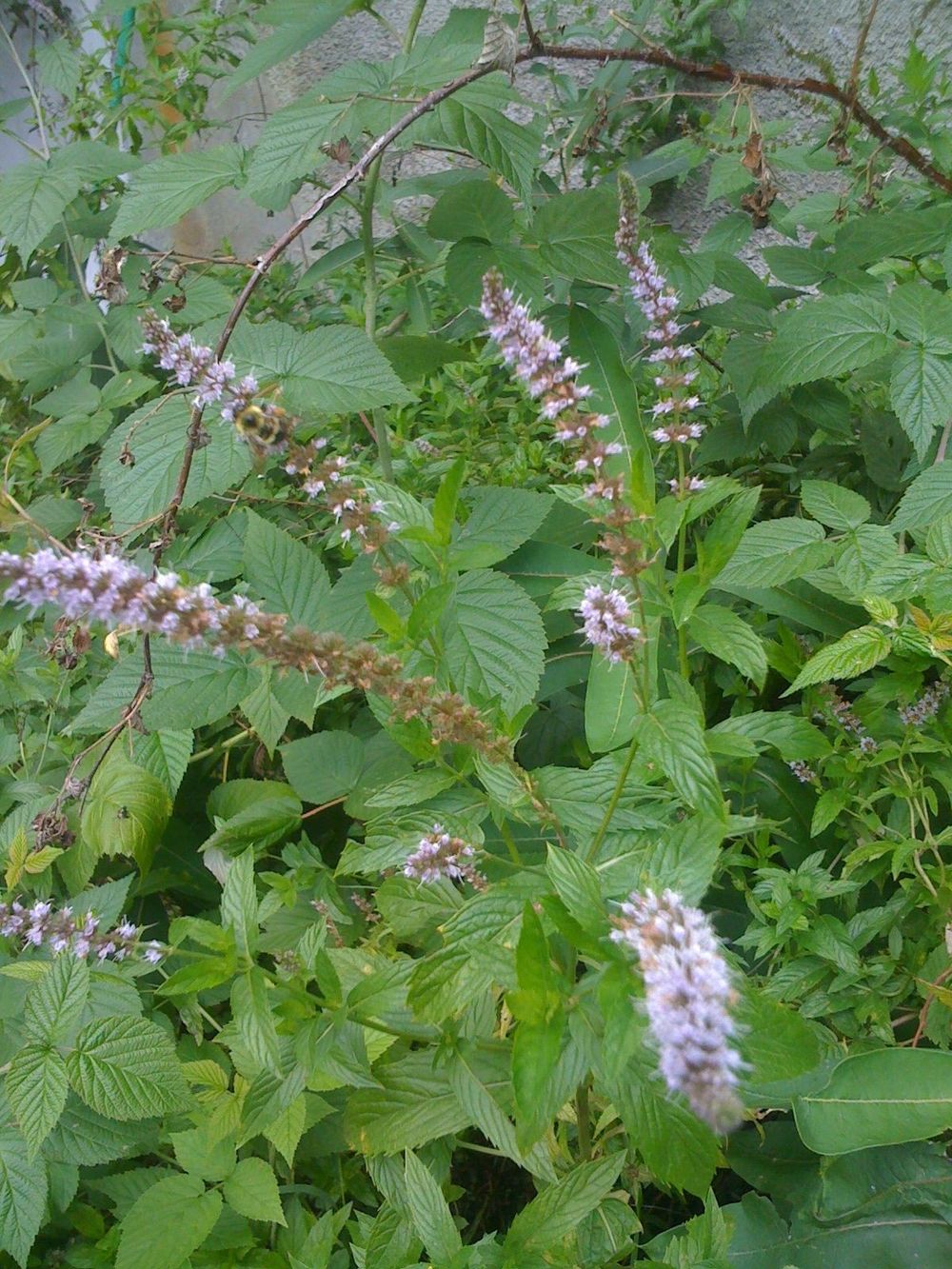
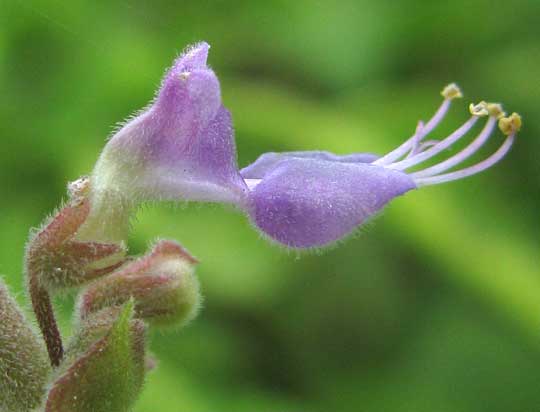
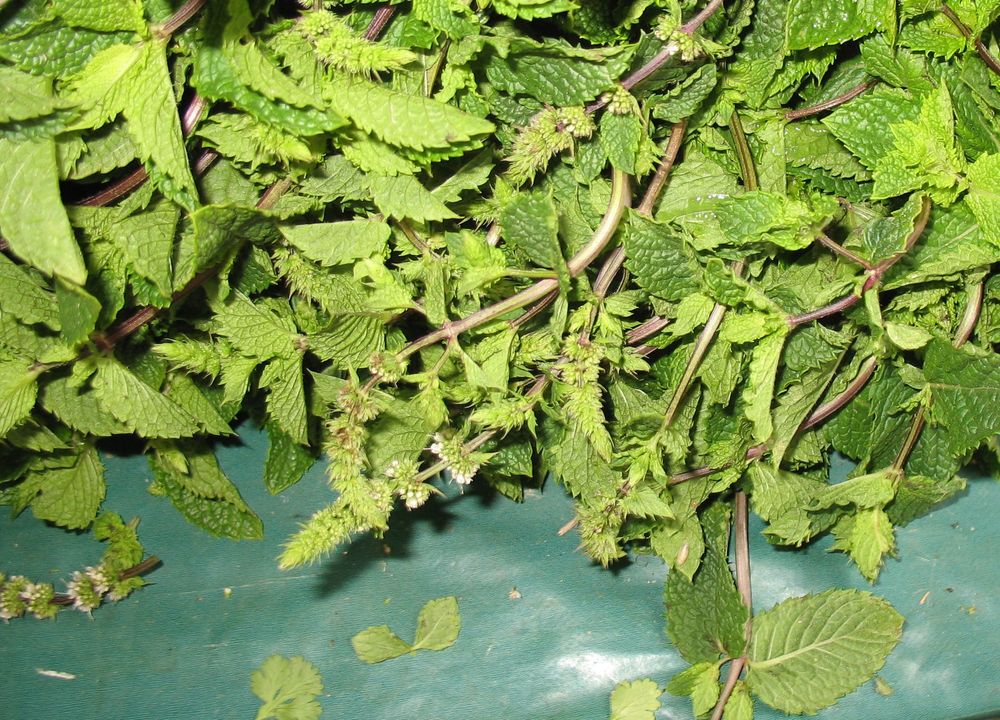
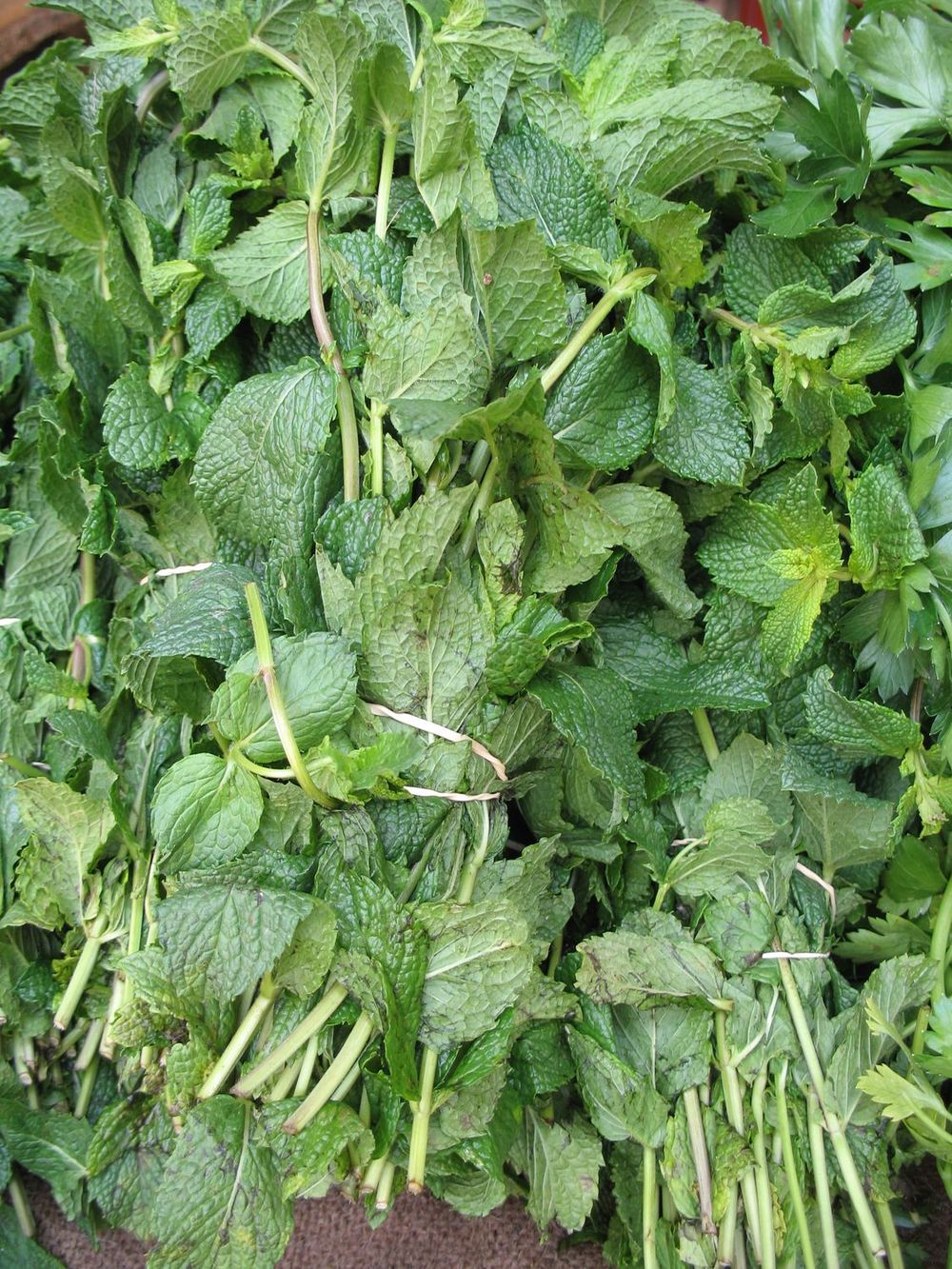
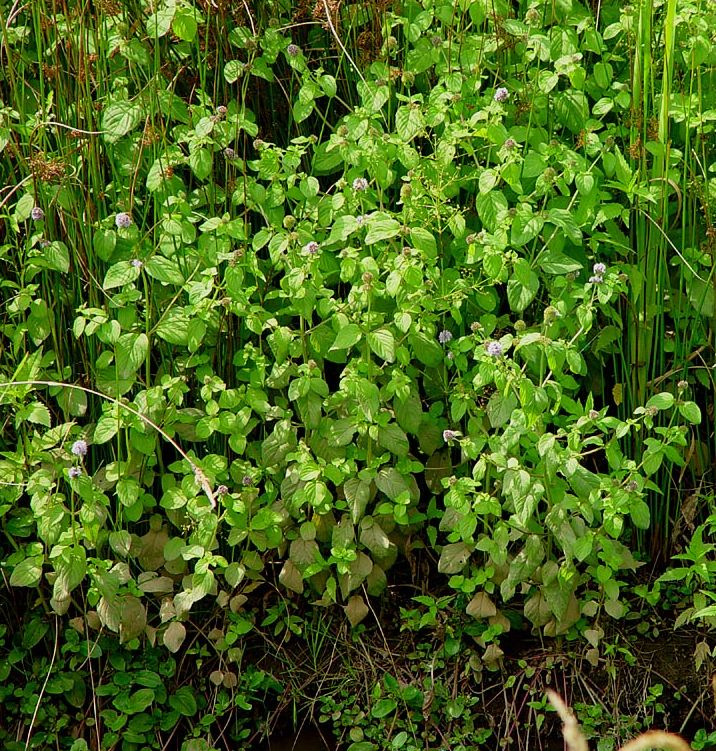
Mint is a small, modest-looking herb with a powerful scent, as expressed in the Greek myth of the nymph Mintha: abandoned by her lover, the king of the underworld, for a more noble goddess, she is transformed by the latter into a small, insignificant herb, but her ex-lover grants her the right to become a fragrant plant called minthé, “with a good smell”. The Lao language refers to this good smell to name the plant: mint is “the vegetable that smells good”, phak hom, and is thus the paradigm of the aromatic plants, the “fine herbs” we have already mentioned.
Mint, or rather mints, are herbaceous perennials with angular stems that propagate by stolons; the leaves, which vary in shape depending on the species, are opposite, toothed and highly aromatic; the flowers are grouped in dense whorls forming spikes or heads. Among the most commonly cultivated are spearmint, M. spicata, native to Europe, which gives its fragrance to the famous mint tea of North Africa; peppermint, M. piperata, which is thought to be a hybrid of spearmint and peppermint. piperata, thought to be a hybrid of the former, has a very fresh, aromatic scent, with an “icicle” effect, as in “menthol-fresh” chewing gum; M. crispa, on the other hand, has a more herbal, green-grass scent, reminiscent of “chlorophyll-flavored” chewing gum. M. arvensis, phak hom gnipoun, is also found in Laos, from which the Japanese have been extracting an essential oil for centuries. Markets all over the world sell a large number of hybrids whose species of origin is difficult to determine, and which can be distinguished by the shape of their leaves and their more or less peppery, more or less mentholated scent, to which, as with wines, tones of orange, pineapple, grapefruit, apple and even eau de Cologne are attributed.
While in the West mint is not traditionally used in cooking (with the exception of the famous and not very good English mint sauce), in the East the leaves are a common ingredient in many culinary preparations. In Laos, mint is sometimes called phak hom lap, which is a clear indication of its use, for not only is mint mixed with most laps, but mint leaves are always part of the vegetable platters that accompany them, as well as grilled meat or fish. In Vietnam, you can’t imagine a good phò or bi boun without mint, and spicy Thai beef salads are abundantly covered with these leaves. But mint leaves are never cooked, and are only added as a final ingredient to the various preparations. Cooking mint as an infusion or decoction is a medicinal preparation. In Laos, for example, a lightly salted mint broth is prepared to purify the blood and cleanse the intestines; this use is almost universal, as aromatic plants always have two functions: one is to give flavour to culinary preparations, the other to make them easier to digest. Mint leaves are also used externally for headaches, sprains and insect bites.
While all mints are reputed for their medicinal properties, peppermint is especially cultivated for this purpose, as it can contain up to 90% menthol, which is an antiseptic, antispasmodic and analgesic, and leaves a cold sensation in the mouth. We can’t list all the products that contain it: confectionery, syrups, alcohol, but also medicines, toothpaste, perfumes, household products, insecticides… etc.
Let’s conclude with a French proverb whose interpretation we leave to the reader:
A woman is like a mint leaf: the more you crumple it, the more it smells.
La Menthe est une petite herbe à l’allure modeste mais à l’odeur puissante, c’est ce qu’exprime le mythe grec de la nymphe Mintha: délaissée par son amant, le roi des enfers, pour une déesse plus noble, elle est transformée par celle-ci en une petite herbe insignifiante, son ex-amant lui accordant cependant de devenir une plante odorante appelée minthé, « à la bonne odeur ». La langue lao se réfère à cette bonne odeur pour nommer la plante: la menthe est « le légume qui sent bon », phak hom, elle est ainsi le paradigme des plantes aromatiques, des « fines herbes » que nous avons déjà évoquées.
La menthe, il faudrait plus tôt dire les menthes, sont des herbacées vivaces aux tiges anguleuses qui se propagent par stolons; les feuilles dont la forme varie selon les espèces sont opposées, dentées et très aromatiques; les fleurs sont groupées en verticilles denses formant des épis ou des têtes. Parmi les plus couramment cultivées on peut citer la menthe verte, M. spicata, originaire d’Europe qui donne son parfum au fameux thé à la menthe d’Afrique du Nord; la menthe poivrée, M. piperata qui serait un hybride de la précédente, a une odeur aromatique très fraîche, avec un effet “glaçon”, comme dans les chewing-gum à la “fraîcheur menthol”; M. crispa a, elle, une odeur plus végétale d’herbe verte et évoque les chewing-gums au “goût chlorophylle”. On trouve aussi au Laos M. arvensis, phak hom gnipoun, dont les Japonais extraient depuis des siècles une huile essentielle. Sur les marchés du monde entier sont vendus de très nombreux hybrides dont il est difficile de déterminer l’espèce d’origine et qui se distinguent par la forme de leur feuille et leur odeur plus ou moins poivrée, plus ou moins mentholée à laquelle on attribue, comme pour les vins, des tonalités d’orange, d’ananas, de pamplemousse, de pomme et même d’eau de Cologne.
Alors que traditionnellement en Occident la menthe n’est pas employée en cuisine (exception faite de la célèbre et pas très bonne sauce à la menthe anglaise), en Orient les feuilles sont un ingrédient courant d’un grand nombre de préparations culinaires. Au Laos on nomme parfois la menthe phak hom lap, ce qui marque bien un usage, car non seulement on mélange de la menthe à la plupart des lap, mais encore les feuilles de menthe font toujours partie des plateaux de légumes les accompagnant ainsi d’ailleurs que les viandes ou poissons grillés. Au Vietnam on ne peut imaginer un bon phò ou un bon bi boun sans menthe, et les salades de bœuf épicées thaï sont abondamment recouvertes de ces feuilles. Mais les feuilles de menthe ne sont jamais cuites, elles ne sont ajoutées qu’en dernier lieu aux différentes préparations. La cuisson de la menthe, en infusion ou en décoction relève d’une préparation médicinale. Ainsi au Laos on prépare un bouillon de menthe légèrement salé pour purifier le sang et nettoyer les intestins; cet usage est quasi universel car les plantes aromatiques ont toujours deux fonctions: l’une de donner du goût aux préparations culinaires, l’autre de permette de les mieux digérer. On emploie aussi les feuilles de menthe en applications externes en cas de mal à la tête, d’entorse et de piqûres d’insectes.
Si toutes les menthes sont réputées pour leurs propriétés médicinales, c’est surtout la menthe poivrée qui est cultivée à cet effet, elle peut renfermer en effet jusqu’à 90% de menthol qui est un antiseptique, un antispasmodique et un analgésique et qui laisse cette sensation de froid dans la bouche; on ne saurait énumérer tous les produits qui en contiennent: confiseries, sirops, alcool, mais aussi médicaments, dentifrice, parfums, produits ménagers, insecticides…etc.
Concluons avec un proverbe français dont nous laissons au lecteur l’interprétation qui lui plaira:
La femme est une feuille de menthe: plus on la froisse, plus elle embaume.










Mint is a small, modest-looking herb with a powerful scent, as expressed in the Greek myth of the nymph Mintha: abandoned by her lover, the king of the underworld, for a more noble goddess, she is transformed by the latter into a small, insignificant herb, but her ex-lover grants her the right to become a fragrant plant called minthé, “with a good smell”. The Lao language refers to this good smell to name the plant: mint is “the vegetable that smells good”, phak hom, and is thus the paradigm of the aromatic plants, the “fine herbs” we have already mentioned.
Mint, or rather mints, are herbaceous perennials with angular stems that propagate by stolons; the leaves, which vary in shape depending on the species, are opposite, toothed and highly aromatic; the flowers are grouped in dense whorls forming spikes or heads. Among the most commonly cultivated are spearmint, M. spicata, native to Europe, which gives its fragrance to the famous mint tea of North Africa; peppermint, M. piperata, which is thought to be a hybrid of spearmint and peppermint. piperata, thought to be a hybrid of the former, has a very fresh, aromatic scent, with an “icicle” effect, as in “menthol-fresh” chewing gum; M. crispa, on the other hand, has a more herbal, green-grass scent, reminiscent of “chlorophyll-flavored” chewing gum. M. arvensis, phak hom gnipoun, is also found in Laos, from which the Japanese have been extracting an essential oil for centuries. Markets all over the world sell a large number of hybrids whose species of origin is difficult to determine, and which can be distinguished by the shape of their leaves and their more or less peppery, more or less mentholated scent, to which, as with wines, tones of orange, pineapple, grapefruit, apple and even eau de Cologne are attributed.
While in the West mint is not traditionally used in cooking (with the exception of the famous and not very good English mint sauce), in the East the leaves are a common ingredient in many culinary preparations. In Laos, mint is sometimes called phak hom lap, which is a clear indication of its use, for not only is mint mixed with most laps, but mint leaves are always part of the vegetable platters that accompany them, as well as grilled meat or fish. In Vietnam, you can’t imagine a good phò or bi boun without mint, and spicy Thai beef salads are abundantly covered with these leaves. But mint leaves are never cooked, and are only added as a final ingredient to the various preparations. Cooking mint as an infusion or decoction is a medicinal preparation. In Laos, for example, a lightly salted mint broth is prepared to purify the blood and cleanse the intestines; this use is almost universal, as aromatic plants always have two functions: one is to give flavour to culinary preparations, the other to make them easier to digest. Mint leaves are also used externally for headaches, sprains and insect bites.
While all mints are reputed for their medicinal properties, peppermint is especially cultivated for this purpose, as it can contain up to 90% menthol, which is an antiseptic, antispasmodic and analgesic, and leaves a cold sensation in the mouth. We can’t list all the products that contain it: confectionery, syrups, alcohol, but also medicines, toothpaste, perfumes, household products, insecticides… etc.
Let’s conclude with a French proverb whose interpretation we leave to the reader:
A woman is like a mint leaf: the more you crumple it, the more it smells.
La Menthe est une petite herbe à l’allure modeste mais à l’odeur puissante, c’est ce qu’exprime le mythe grec de la nymphe Mintha: délaissée par son amant, le roi des enfers, pour une déesse plus noble, elle est transformée par celle-ci en une petite herbe insignifiante, son ex-amant lui accordant cependant de devenir une plante odorante appelée minthé, « à la bonne odeur ». La langue lao se réfère à cette bonne odeur pour nommer la plante: la menthe est « le légume qui sent bon », phak hom, elle est ainsi le paradigme des plantes aromatiques, des « fines herbes » que nous avons déjà évoquées.
La menthe, il faudrait plus tôt dire les menthes, sont des herbacées vivaces aux tiges anguleuses qui se propagent par stolons; les feuilles dont la forme varie selon les espèces sont opposées, dentées et très aromatiques; les fleurs sont groupées en verticilles denses formant des épis ou des têtes. Parmi les plus couramment cultivées on peut citer la menthe verte, M. spicata, originaire d’Europe qui donne son parfum au fameux thé à la menthe d’Afrique du Nord; la menthe poivrée, M. piperata qui serait un hybride de la précédente, a une odeur aromatique très fraîche, avec un effet “glaçon”, comme dans les chewing-gum à la “fraîcheur menthol”; M. crispa a, elle, une odeur plus végétale d’herbe verte et évoque les chewing-gums au “goût chlorophylle”. On trouve aussi au Laos M. arvensis, phak hom gnipoun, dont les Japonais extraient depuis des siècles une huile essentielle. Sur les marchés du monde entier sont vendus de très nombreux hybrides dont il est difficile de déterminer l’espèce d’origine et qui se distinguent par la forme de leur feuille et leur odeur plus ou moins poivrée, plus ou moins mentholée à laquelle on attribue, comme pour les vins, des tonalités d’orange, d’ananas, de pamplemousse, de pomme et même d’eau de Cologne.
Alors que traditionnellement en Occident la menthe n’est pas employée en cuisine (exception faite de la célèbre et pas très bonne sauce à la menthe anglaise), en Orient les feuilles sont un ingrédient courant d’un grand nombre de préparations culinaires. Au Laos on nomme parfois la menthe phak hom lap, ce qui marque bien un usage, car non seulement on mélange de la menthe à la plupart des lap, mais encore les feuilles de menthe font toujours partie des plateaux de légumes les accompagnant ainsi d’ailleurs que les viandes ou poissons grillés. Au Vietnam on ne peut imaginer un bon phò ou un bon bi boun sans menthe, et les salades de bœuf épicées thaï sont abondamment recouvertes de ces feuilles. Mais les feuilles de menthe ne sont jamais cuites, elles ne sont ajoutées qu’en dernier lieu aux différentes préparations. La cuisson de la menthe, en infusion ou en décoction relève d’une préparation médicinale. Ainsi au Laos on prépare un bouillon de menthe légèrement salé pour purifier le sang et nettoyer les intestins; cet usage est quasi universel car les plantes aromatiques ont toujours deux fonctions: l’une de donner du goût aux préparations culinaires, l’autre de permette de les mieux digérer. On emploie aussi les feuilles de menthe en applications externes en cas de mal à la tête, d’entorse et de piqûres d’insectes.
Si toutes les menthes sont réputées pour leurs propriétés médicinales, c’est surtout la menthe poivrée qui est cultivée à cet effet, elle peut renfermer en effet jusqu’à 90% de menthol qui est un antiseptique, un antispasmodique et un analgésique et qui laisse cette sensation de froid dans la bouche; on ne saurait énumérer tous les produits qui en contiennent: confiseries, sirops, alcool, mais aussi médicaments, dentifrice, parfums, produits ménagers, insecticides…etc.
Concluons avec un proverbe français dont nous laissons au lecteur l’interprétation qui lui plaira:
La femme est une feuille de menthe: plus on la froisse, plus elle embaume.


